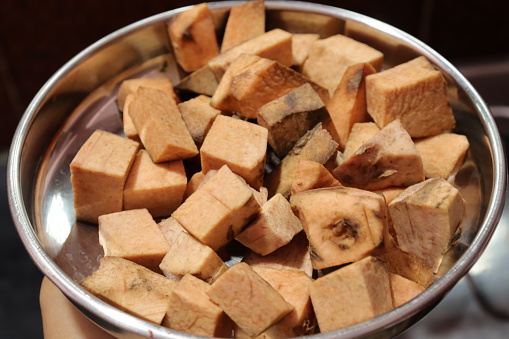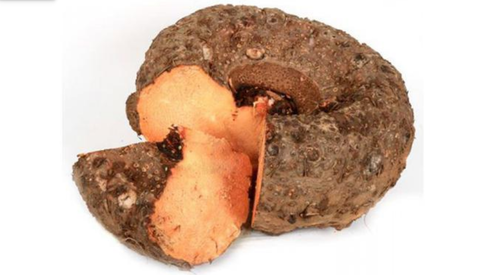

Amorphophallus paeoniifolius (Dennst.) Nicolson
|
Elephant Foot Yam is commonly known as Suran or Jimmikand. It belongs to the family Araceae. The tuber is consumed as vegetable. The phytoconstituents present in the tuber are Betulinic acid, β-sitosterol, Stigmasterol, Lupeol, Palmitate, Glucose, Galactose, Rhamnose and Xylose. Tuber extract of A. paeoniifolius induces apoptosis and suppresses migration of breast cancer cells. Treatment with methanolic extract of A. paeoniifolius (250 and 500 mg/kg) and aqueous extract (250 and 500 mg/kg) significantly decreased TNF-α and interleukin (IL-6) levels in Croton oil induced Hemorrhoid rats showing anti-inflammatory activity. Mode of Consumption : Corm and petioles into curry, leaves into snacks |
| Plant Details | Agro-climatic Zone | Vernacular Names | Pictures |
| Scientific Name: Amorphophallus paeoniifolius (Dennst.) Nicolson Family: Araceae Juss. Class: Magnoliopsida Order: Alismatales Genus: Amorphophallus Blume ex Decne. Fruiting Season: All round the year Parts: Corm & Tender petioles |
|
Andhra Pradesh : Kanda Gadda Arunachal Pradesh : Khoebi Assam : Ol-kochu Bihar : Jimikand Himachal Pradesh : Jimikand Karnataka : Suvarna gedde Kerala : Chena Manipur : Kolbot Odisha : Oluo Tamil Nadu : Kizhangu, Senai kingalu Uttar Pradesh : Suran, Suranakanda, Jimikanda West Bengal : Ole |
 Sliced pieces of tuber  Tuber |
| Compound/Extract | Activity | Mode of Action | Marker/References |
| Methanolic extract | Anti-inflammatory, Antioxidant | Treatment with methanolic extract (250 and 500 mg/kg) and aqueous extract (250 and 500 mg/kg) significantly decreased TNF-α and interleukin (IL-6) levels (p<0.05-p<0.001) compared to hemorrhoid control. | TNF-α and IL-6[2] |
| Tuber extract | Anticancer | Increase of pro-apoptotic BAX and inhibition of antiapoptotic BCL-2 indicated induction of apoptosis, release of Cytochrome c from mitochondria and initiation of CASPASE 7 activation pathway. | Bcl-2, Caspase-7, and PARP[3] |
| Methanolic and aqueous extract | Anti-inflammatory, Antioxidant | Methanolic and aqueous extract exhibited a preventive effect on acetic acid-induced ulcerative colitis (UC) in rats and reduced (p < .001) alkaline phosphatase (ALP) and lactate dehydrogenase (LDH) in serum, and also reduced myeloperoxidase (MPO) activity and cytokines in colon tissue. | ALP, LDH, and MPO[4] |
| Major Class | Metabolites (Content of bioactives: mg/100g Fresh Weight) |
| Carboxylic Acid | Gallic acid: , Methyl jasmonate: [3] |
| Carotenoid | β- Carotene : 0.18[9] |
| Fatty acid | Palmitate: [2] |
| Flavonoid | Cosmosiin: , Flavonoid: 774.48 -972.73 mg/100g, Kaempferol : 0.26, Rutin: [2] |
| Flavonol | Fisetin: , Quercetin: [6] |
| Glyceride | 1-Monopalmitin: [3] |
| Heterotetracyclic compound | Dihydrogambogic acid: [3] |
| Oxalate | Oxalate: 108.6-310.4 mg/100g |
| Phenolic acid | Mallic acid : 122, Polyphenol: 81.9-92.4 mg/100g |
| Phytosterol | Stigmasterol: , β-sitosterol: [2] |
| Polysaccharide | Glucomannan: [2] |
| Sphingoid base | C16-Sphinganine: [3] |
| Sugar | Phytic acid : 16.23[9] |
| Terpene | Amblyone: , Betulinic acid: , Lupeol: [2] |
| Vitamin | Pyridoxine: [3] |
| Effect | Observation | DOI |
| In vitro studies | Increase in Bifidobacterium genus, Lactobacillus–Enterococcus group and the Atopobium and also increase in SCFA | DOI: 10.1016/j.jff.2010.05.001 |
| Disease | Formulation | Reference | Author | TKDL |
| Piles/Haemorrhoids, Sprue/Malabsorption Syndrome, Anaemia/Hyperbilirubinaemia, Anorexia, Worm infestation, Abdominal lump, Stone in Urinary Bladder/Urolithiasis/Urinary Calculus, Urinary disorders/Polyuria, Colic, and Premature grey hair/Canities | Bhallatakaleha | Vrindamadhava | Written by Madhava; Marathi translated by Datto vallala Borkar | Ayurveda |
| Piles/Haemorrhoids, Anaemia/Hyperbilirubinaemia, Perineal fistulas, Sprue/Malabsorption Syndrome, Emaciation/Cachexia, Colic, Flatulence associated with constipation, Constipation, Abdominal lump, Jaundice | Bhimasenavatakah | Bharata Bhaishajya Ratnakara - Vol.-III | Compiled by Naginadasa Chaganalala Shah; Translated by Gopinath Gupta | Ayurveda |
| Intellect promoting, Lusture promoting, Strength promoting, Strength promoting, in Ligament, Nerves, Clearing vision, Semenpromoting, useful in the treatment of Cough/Bronchitis, Leprosy, Colic, Disease, Gonorrhoea | Abraha Parpam | Matchamuni Perunool -800.CCRAS Publications. Chennai.(1985). | Matchamuni, CCRAS, New Delhi (Edn. 1st, 1985) | Siddha |
| Information from Wealth of India | Reference |
|
CSIR(1948).The Wealth of India, Raw materials,Vol.-I ,P.69-70, New Delhi, India |
| 4.2, 4.2.1, 4.2.1.1, 4.2.1.2, 4.2.1.3, 4.2.2, 4.2.2.1, 4.2.2.2, 4.2.2.3, 4.2.2.4, 4.2.2.5, 4.2.2.7, 4.2.2.8 |
|
| CSIR-North East Institute of Science and Technology, Jorhat-6, Assam, India
CSIR-Institute of Himalayan Bioresource Technology, Palampur-61,Himachal Pradesh, India |